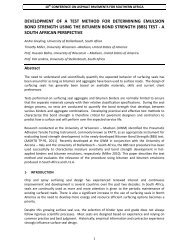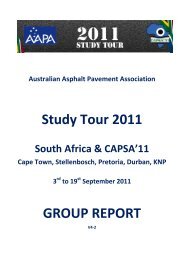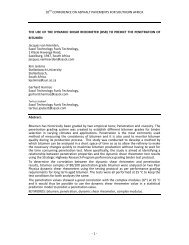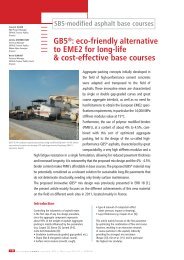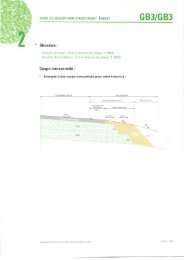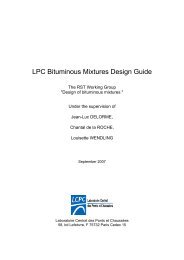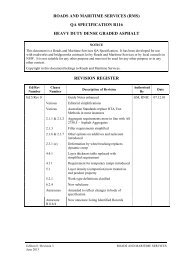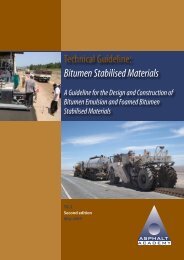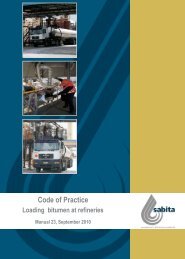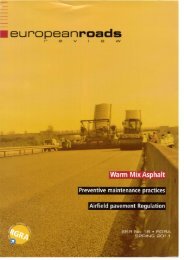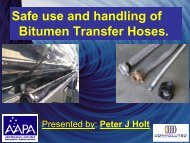Guide to the safe handling of solvents in a bituminous ... - Aapaq.org
Guide to the safe handling of solvents in a bituminous ... - Aapaq.org
Guide to the safe handling of solvents in a bituminous ... - Aapaq.org
- No tags were found...
Create successful ePaper yourself
Turn your PDF publications into a flip-book with our unique Google optimized e-Paper software.
Be prepared <strong>to</strong> repeat <strong>the</strong> process if <strong>the</strong> fire breaks out aga<strong>in</strong>.• Prevent<strong>in</strong>g fires: Use <strong>the</strong> follow<strong>in</strong>g precautions when work<strong>in</strong>g withor us<strong>in</strong>g flammable chemicals <strong>in</strong> a labora<strong>to</strong>ry, and keep <strong>in</strong> m<strong>in</strong>d that<strong>the</strong>se precautions also apply <strong>to</strong> flammable chemical waste: M<strong>in</strong>imise <strong>the</strong> quantities <strong>of</strong> flammable liquids kept <strong>in</strong> <strong>the</strong> labora<strong>to</strong>ry; Do not exceed <strong>the</strong> maximum conta<strong>in</strong>er sizes specified by <strong>the</strong>National Fire Protection Association (NFPA); Except for <strong>the</strong> quantities needed for <strong>the</strong> work at hand, keep allflammable liquids <strong>in</strong> NFPA or UL (underwriters' labora<strong>to</strong>ries)approved flammable liquid s<strong>to</strong>rage cab<strong>in</strong>ets. Keep cab<strong>in</strong>et doorsclosed and latched at all times. Do not s<strong>to</strong>re o<strong>the</strong>r materials <strong>in</strong><strong>the</strong>se cab<strong>in</strong>ets; Use and s<strong>to</strong>re flammable liquids and gases only <strong>in</strong> well-ventilatedareas. Use a fume hood when work<strong>in</strong>g with products that releaseflammable vapours; Keep flammable solvent conta<strong>in</strong>ers, <strong>in</strong>clud<strong>in</strong>g those for collect<strong>in</strong>gwaste, well capped. Place open reservoirs or collection vessels for<strong>org</strong>anic procedures like HPLC <strong>in</strong>side vented chambers; S<strong>to</strong>re flammable chemicals that require refrigeration <strong>in</strong>“explosion-<strong>safe</strong>” (non-spark<strong>in</strong>g) labora<strong>to</strong>ry refrigera<strong>to</strong>rs; Keep flammable chemicals away from ignition sources, such asheat, sparks, flames and direct sunlight. Avoid weld<strong>in</strong>g orsolder<strong>in</strong>g <strong>in</strong> <strong>the</strong> vic<strong>in</strong>ity <strong>of</strong> flammables; Bond and ground large metal conta<strong>in</strong>ers <strong>of</strong> flammable liquids <strong>in</strong>s<strong>to</strong>rage. To avoid <strong>the</strong> build-up <strong>of</strong> static charges, bond conta<strong>in</strong>ers<strong>to</strong> each o<strong>the</strong>r when dispens<strong>in</strong>g; Use portable <strong>safe</strong>ty cans for s<strong>to</strong>r<strong>in</strong>g, dispens<strong>in</strong>g and transport<strong>in</strong>gflammable liquids; Clean spills <strong>of</strong> flammable liquids promptly.• Evacuations: In <strong>the</strong> event that <strong>the</strong> general alarm is sounded, follow<strong>the</strong> evacuation routes established for your area; do not use <strong>the</strong>eleva<strong>to</strong>rs. Follow <strong>the</strong> <strong>in</strong>structions <strong>of</strong> <strong>the</strong> evacuation moni<strong>to</strong>rs. Onceoutside <strong>the</strong> build<strong>in</strong>g, move away from <strong>the</strong> doors <strong>to</strong> allow o<strong>the</strong>rs <strong>to</strong> exit;• Gas Safety - hazards <strong>of</strong> compressed gases: Compressed gasesare hazardous due <strong>to</strong> <strong>the</strong> high pressure <strong>in</strong>side cyl<strong>in</strong>ders. Knock<strong>in</strong>gover an unsecured, uncapped cyl<strong>in</strong>der <strong>of</strong> compressed gas can break<strong>the</strong> cyl<strong>in</strong>der valve, and <strong>the</strong> result<strong>in</strong>g rapid escape <strong>of</strong> high pressuregas can turn a cyl<strong>in</strong>der <strong>in</strong><strong>to</strong> an uncontrolled rocket or p<strong>in</strong>wheel,53



